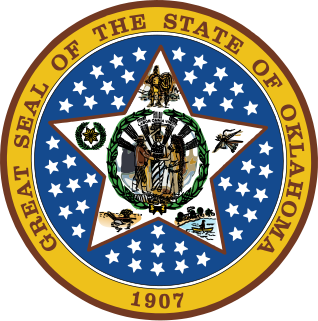
The Constitution of the State of Vermont is the fundamental body of law of the U.S. state of Vermont. It was adopted in 1793 following Vermont's admission to the Union in 1791 and is largely based upon the 1777 Constitution of the Vermont Republic which was ratified at Windsor in the Old Constitution House and amended in 1786. At 8,295 words, it is the shortest U.S. state constitution.

In political science, an initiative is a means by which a petition signed by a certain minimum number of registered voters can force a public vote in parliament called an indirect initiative or via a direct initiative, the latter then being dubbed a Popular initiated Referendum.

The Constitution of the Commonwealth of Massachusetts is the fundamental governing document of the Commonwealth of Massachusetts, one of the 50 individual state governments that make up the United States of America. As a member of the Massachusetts Constitutional Convention of 1779, John Adams was the document's principal author. Voters approved the document on June 15, 1780. It became effective on October 25, 1780, and remains the oldest functioning written constitution in continuous effect in the world. It was also the first constitution anywhere to be created by a convention called for that purpose rather than by a legislative body. Only the Constitution of San Marino has sections still in force that are older.
A constitutional amendment is a modification of the constitution of a polity, organization or other type of entity. Amendments are often interwoven into the relevant sections of an existing constitution, directly altering the text. Conversely, they can be appended to the constitution as supplemental additions (codicils), thus changing the frame of government without altering the existing text of the document.
A constituent assembly or constitutional assembly is a body or assembly of popularly elected representatives composed for the purpose of drafting or adopting a constitutional-type document. The constituent assembly is a subset of a constitutional convention elected entirely by popular vote; that is, all constituent assemblies are constitutional conventions, but a constitutional convention is not necessarily a constituent assembly. As the fundamental document constituting a state, a constitution cannot normally be modified or amended by the state's normal legislative procedures; instead a constitutional convention or a constituent assembly, the rules for which are normally laid down in the constitution, must be set up. A constituent assembly is usually set up for its specific purpose, which it carries out in a relatively short time, after which the assembly is dissolved. A constituent assembly is a form of representative democracy.

The Constitutional Convention took place from May 25 to September 17, 1787, in the old Pennsylvania State House in Philadelphia. Although the Convention was intended to revise the league of states and first system of government under the Articles of Confederation, the intention from the outset of many of its proponents, chief among them James Madison of Virginia and Alexander Hamilton of New York, was to create a new government rather than fix the existing one. The delegates elected George Washington of Virginia, former commanding general of the Continental Army in the late American Revolutionary War (1775–1783) and proponent of a stronger national government, to preside over the Convention. The result of the Convention was the creation of the Constitution of the United States, placing the Convention among the most significant events in American history.

The Constitution of the State of Connecticut is the basic governing document of the U.S. state of Connecticut. It was approved by referendum on December 14, 1965, and proclaimed by the governor as adopted on December 30. It comprises 14 articles and has been amended 31 times.

The Constitution of California is the primary organizing law for the U.S. state of California, describing the duties, powers, structures and functions of the government of California. Following cession of the area from Mexico to the United States in the Treaty of Guadalupe Hidalgo that ended the Mexican–American War, California's original constitution was drafted in both English and Spanish by delegates elected on August 1, 1849, to represent all communities home to non-indigenous citizens. The delegates wrote and adopted the constitution at the 1849 Constitutional Convention, held beginning on September 3 in Monterey, and voters approved the new constitution on November 13, 1849. Adoption of the "state" constitution actually preceded California's Admission to the Union on September 9, 1850 by almost ten months.

Theophilus Parsons was an American jurist.
The Constitution of the State of New Hampshire is the fundamental law of the State of New Hampshire, with which all statute laws must comply. The constitution became effective June 2, 1784, when it replaced the state's constitution of 1776.
The Ohio Constitution is the basic governing document of the State of Ohio, which in 1803 became the 17th state to join the United States of America. Ohio has had three constitutions since statehood was granted.
The Constitution of the State of New York establishes the structure of the government of the State of New York, and enumerates the basic rights of the citizens of New York. Like most state constitutions in the United States, New York's constitution's provisions tend to be more detailed, and amended more often than its federal counterpart. Because the history of the state constitution differs from the federal constitution, the New York Court of Appeals has seen fit to interpret analogous provisions differently from United States Supreme Court's interpretation of federal provisions.

The Constitution of the State of Oklahoma is the governing document of the U.S. State of Oklahoma. Adopted in 1907, Oklahoma ratified the United States Constitution on November 16, 1907, as the 46th U.S. state. At its ratification, the Oklahoma Constitution was the most lengthy governing document of any government in the U.S. All U.S. state constitutions are subject to federal judicial review; any provision can be nullified if it conflicts with the U.S. Constitution.
The Constitution of the State of Wisconsin is the governing document of the U.S. State of Wisconsin. It establishes the structure and function of state government, describes the state boundaries, and declares the rights of state citizens. The Wisconsin Constitution was written at a constitutional convention held in Madison, Wisconsin in December 1847 and approved by the citizens of Wisconsin Territory in a referendum held in March 1848. Wisconsin was admitted to the United States on May 29, 1848. Although it has been amended over a hundred times, the original constitution ratified in 1848 is still in use. This makes the Wisconsin Constitution the oldest U.S. state constitution outside of New England. Only Massachusetts, New Hampshire, Vermont, Maine, and Rhode Island use older constitutions.
The Massachusetts Constitutional Convention of 1853 met in order to consider changes to the Massachusetts Constitution. This was the third such convention in Massachusetts history held by delegates selected for the purpose: the first, in 1779–80, had drawn up the original document, while the second, in 1820–21, submitted a number of articles to a popular vote, resulting in the adoption of the first nine amendments and the rejection of a number of other proposals. Since 1853, Massachusetts has had one subsequent constitutional convention, in 1917–18.

The drafting of the Constitution of the United States began on May 25, 1787, when the Constitutional Convention met for the first time with a quorum at the Pennsylvania State House in Philadelphia, Pennsylvania to revise the Articles of Confederation, and ended on September 17, 1787, the day the Constitution drafted by the convention's delegates to replace the Articles was adopted and signed. The ratification process for the Constitution began that day, and ended when the final state, Rhode Island, ratified it on May 29, 1790. In addition to key events during the Constitutional Convention and afterward while the Constitution was before the states for their ratification, this timeline includes important events that occurred during the run-up to the convention and during the nation's transition from government under the Articles of Confederation to government under the Constitution, and concludes with the unique ratification vote of Vermont, which at the time was a sovereign state outside the Union. The time span covered is 5 years, 9 months, from March 25, 1785 to January 10, 1791.

The Oregon Constitutional Convention in 1857 drafted the Oregon Constitution in preparation for the Oregon Territory to become a U.S. state. Held from mid-August through September, 60 men met in Salem, Oregon, and created the foundation for Oregon's law. The proposal passed with a vote of 35 for adoption to 10 against. Oregon then became the 33rd state of the Union on February 14, 1859.
The Constitutional Convention of 1779–1780 was the second constitutional convention held in Massachusetts to draft a new state constitution following the state's declaration of independence in 1776. The convention that drafted the proposed constitution was composed of delegates specifically elected for the purpose, unlike the previous year's convention, which had been composed of legislators. The convention's proposal was principally drafted by John Adams, and was published in early March 1780. After an extended process of ratification debates involving town meetings, the convention approved a modified version of the March proposal on June 15, 1780, although the vote to do so was not without some controversy. The new Massachusetts State Constitution then went into effect, and the convention on June 16 issued a call to elect a governor and General Court under its terms before it finally adjourned.

New York Proposition 1 was a 2017 ballot measure that would have established a constitutional convention to revise the Constitution of the State of New York, subject to the approval of the voters. Section 2 of Article XIX of the state constitution requires that every 20 years the ballot question "Shall there be a convention to revise the constitution and amend the same?" should be submitted to the voters. The referendum was rejected by a large margin on November 7, 2017.











